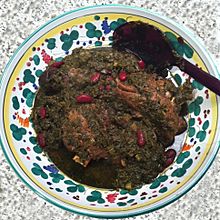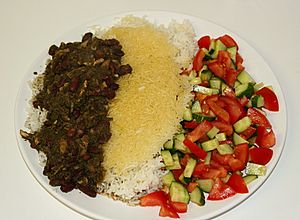Ghormeh sabzi facts for kids
 |
|
| Alternative names | Khoresh sabzi, koresht sabzi, ghormeh sabzi, qormeh sabzi |
|---|---|
| Type | Stew |
| Course | Main course |
| Place of origin | |
| Associated national cuisine | |
| Created by | Iranians |
| Main ingredients | Herbs, kidney beans, dried lime, lamb |
Ghormeh sabzi (Persian: قورمه سبزی), also known as khoresht sabzi (Persian: خورشت سبزی), is a very famous and delicious Iranian herb stew. Many people consider it the national dish of Iran because it's so popular there.
Contents
The Story of Ghormeh Sabzi
This special stew has a really long history! Ghormeh sabzi started in Iran about 5,000 years ago. That's a super long time for a recipe to be around!
What Does the Name Mean?
The name Ghormeh sabzi tells you a lot about the dish. Ghormeh comes from the Persian word for "braised," which means cooked slowly in liquid. Sabzi is the Persian word for "herbs." So, it's a stew made with braised herbs!
How to Make Ghormeh Sabzi
The main parts of Ghormeh sabzi are a mix of fresh herbs that are cooked until they are soft. These herbs usually include parsley, leeks (or green onions), and coriander. A key spice that gives it a special taste is dried fenugreek leaves.
There are many ways to mix the herbs. Sometimes, people add other dark, leafy greens like kale or mustard greens. However, these aren't part of the very old, original recipe.
This herb mix is cooked with kidney beans, yellow or red onions, and special black limes. These black limes are dried and pierced to let out their sour flavor. The stew also has turmeric-seasoned lamb or beef. Once it's all cooked, Ghormeh sabzi is often served with polo, which is a type of rice from Persia. Sometimes, it's even served over tahdig, which is the crispy, delicious bottom layer of cooked rice.
People in Iran sometimes have different ideas about the exact ingredients for the best Ghormeh sabzi. Everyone has their favorite way to make it!
Why Ghormeh Sabzi is Important
Ghormeh sabzi is more than just a meal; it's a big part of Iranian culture. Self magazine even said it's one of the most meaningful dishes passed down through families. The Tehran Times called it one of the most important dishes in Persian cooking history.
Iranians who live outside of Iran often celebrate "International Ghormeh Sabzi Appreciation Day." This special day happens two days after Thanksgiving each year. It's a fun way for them to remember their heritage and enjoy this beloved dish together.
See also
 In Spanish: Qormeh sabzi para niños
In Spanish: Qormeh sabzi para niños


